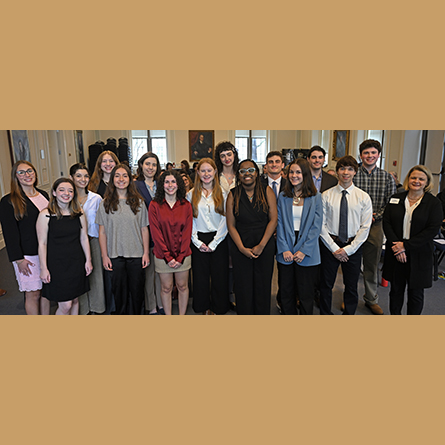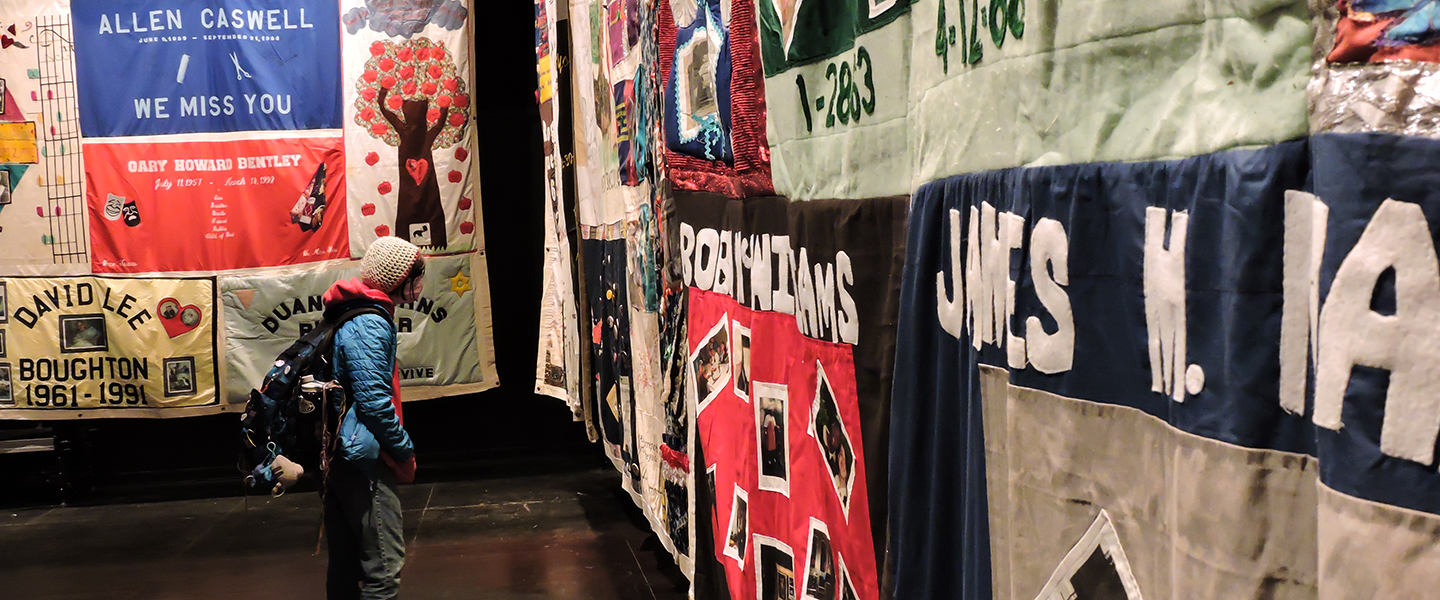
World AIDS Day: AIDS Memorial Quilt on display
Eric Lotring loved Disney, collected pins and was a proud member of the Mickey Mouse Club. He was 31. Christopher Gillis was a member of the Paul Taylor Dance Company, an artist, a choreographer, a brother, a son, a lover, a friend. He was 42. Larry Michael Nelson, from New London, was 39. Linda Marie Moran was just 25. George Kish, who worked at IBM and raised three loving sons, had already lost more than 60 friends to AIDS by the time of his own death in 1992. He was 58.
In Connecticut College’s black box Tansill Theater, dozens of students silently stand before the quilted panels of the AIDS Memorial Quilt that bear their names, images, mementos and stories, each stitched—and many signed—by those who loved them.
In their “Theater of the AIDS Epidemic” course with Associate Professor of Theater Virginia Anderson, the students had learned about the quilt, the premier symbol of the AIDS pandemic, and some had even helped unpack the more than 70 panels on display at Conn through Dec. 4. But being in the presence of the expansive panels, spotlit and hanging floor-to-ceiling on three sides of the room, is a completely different experience.
“When I saw photos of the quilt before it came to Conn, I had no emotional attachment to it,” said Julio Ortiz ’25. “Seeing it in person was very emotional. I spent a half hour alone with the quilt, in complete silence, just taking in every word, every image, every detail, every life.”
This is the third time Anderson, who joined Conn’s faculty in 2013, has brought sections of the quilt to Conn. Originally conceived in 1985 by human rights activist, author and lecturer Cleve Jones, the full quilt now weighs more than 54 tons and is composed of more than 48,000 panels dedicated to more than 94,000 individuals. It is also the largest ongoing piece of community folk art in the world.
“It’s been a goal of mine to host the quilt every four years so every Connecticut College student has an opportunity to experience and learn from it,” Anderson said. “There is so much we can learn about compassion from the quilt. The love and care that went into making each panel really makes you think not only about the lives lost, but also the people who were left behind.”
Anderson said she’s been heartened by the response from the community. Specific panels can be requested; this year she received more requests than ever before. The exhibition also coincides with World AIDS Day, observed on Dec. 1, and hundreds of visitors had already been through in just the first few days.
But it’s been the response from the students—all of whom were born after the height of the epidemic—that has been the most encouraging.
“They are so engaged. And many of them are angry—angry about what happened, but also about the fact that they weren’t taught about what happened,” she said.
Elora Maxwell ’26 is one of those students. “So few of us knew a lot about the epidemic, and some, like me, were taught nothing about it at all,” she said. “We need to remember those who were lost and those who fought for their lives, because it is important for us to see what happens when we let hate and bigotry triumph over compassion and love.”
Maxwell’s classmate Skylar Gould ’26 said the quilt shows “the legacy of AIDS and the lives it took in a form that cannot be denied or minimized.” It is not only a memorial, she said, “but a physical and massive counterargument to the ways AIDS has been ignored in the news and the history books.”
Maddy Fisher ’26 added that seeing the quilt and learning about the AIDS epidemic is motivating for her and her classmates.
“The younger generations are the ones who need to make the change. We are capable of making progress,” she said. “This kind of education, exposure and awareness is just the beginning. It’s simply the launching point.”
The AIDS Memorial Quilt exhibition is free and open to the public 9 a.m.-7 p.m. in Tansill Theater, Hillyer Hall, through Sunday, Dec. 4.


